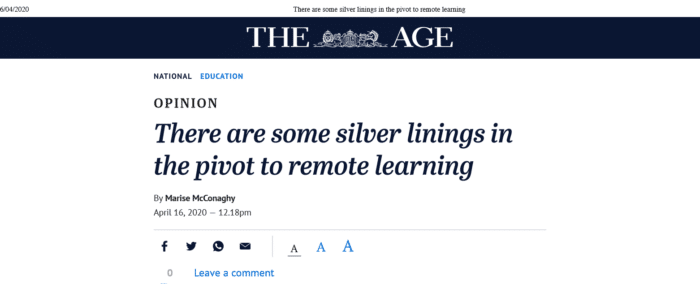In the media: The Age, Sydney Morning Herald, The Brisbane Times, WA Today, 16 April 2020
With the government announcing that schools will effectively remain closed to most students for the next two months, parents, students and educators across the country are bracing themselves for a period of immense uncertainty and challenge.
Like most educators, never in my wildest dreams did I think we would ever have to deliver our whole school’s education remotely. Nor did I think I’d find myself in a position of worrying about my entire school community’s physical and mental wellbeing at the same time.
And while the past few weeks have been enormously challenging, there have been quite a few silver linings presented along the way that have helped to boost our confidence and will allow us to lead with optimism, if somewhat cautiously, into term two.
While we are all grappling with the idea of conducting the entirety of term two from our homes – from physical education to science and math – it’s clear that the ability to innovate and problem solve is helping us move forward.
Giving teachers the agency to adapt and apply creativity in delivering lessons to students has been a masterclass in what it means to be agile in the 21st Century. In no time at all, teachers have dramatically pivoted the way they conduct their work and deliver learning to children.
Teachers who may not have been ones to necessarily assume leadership positions in the past have stepped up and are taking charge of collaborating with other teachers across year levels and disciplines. I myself have most recently collaborated with principals from other schools to work through shared hurdles and am grateful to now be able to find common solutions with those who may have previously been deemed “competitors”.
When it comes to students, they have risen to the challenge and have shown us that they’re capable and resilient when it’s needed the most.
In fact, many of our students have checked in with their teachers to ask about their wellbeing and offer support. Certainly, it is our job as educators to pastorally care for our students, and for school leaders to check in on staff for the same reasons, but how beautiful it is that our students think to do this for their teachers. Teenagers are, after all, not as self-obsessed as they sometimes are made out to be.
One can’t help but feel for this year’s Year 12 cohort, for whom it has already been a difficult year. It’s now more important than ever for parents to be aware of their children’s mental health, how the family dynamic feeds into that, and what positive practices can be used to support their wellbeing during this time.
There’s a long-held misconception that emerging technology has made younger generations socially distant – inept even. However, it is now clear that social proximity is something we’ll always crave as humans and the advent of modern technology means that social distancing and isolation need not turn into social isolation. The camaraderie of their peers is exactly what many children will need at this time.
And while families face the prospect of sharing the kitchen dining table for the next couple of months, these new ways of working will also serve as a lesson for students on what the future of work will look like for them. For older children, the next term will be an important lesson in managing self-motivation and self-care in a future where remote work will be a far more common occurrence for them.
It goes without saying that for today’s school-aged children, the COVID-19 crisis will be a defining moment in time for the rest of their lives. If we do well to step up to the challenge now, we can perhaps instil some lessons that will enable them to face their next challenge with optimism and acuity.
Marise McConaghy is the principal of Strathcona Girls Grammar.


